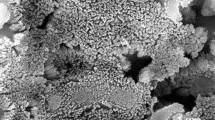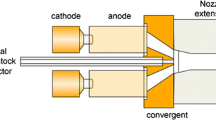Abstract
Suspension plasma spraying (SPS) is a single-step process for the preparation of thick coatings or for the production of powder using radio-frequency inductively coupled thermal plasma technology. SPS is based on a liquid suspension of very fine (<10 μm) or even ultrafine (,100 nm) powders axially fed into the radio-frequency plasma flame through an atomization probe. This article reports the results of the preparation by SPS of thick coatings and spherical powders of bioceramics, namely, hydroxyapatite. Characterization of the hydroxyapatite coatings and atomized powders are reported. Process variables are studied as a function of phase structure and crystallinity of the obtained hydroxyapatite material.
Similar content being viewed by others
References
R.H. Doremus, “Review Bioceramics,”Journal of Mat. Sci., 27 (1992), pp. 285–297.
J.G.C. Wolke et al., “Studies on the Thermal Spraying of Apatite Bioceramics,”J. of Thermal Spray Tech., 1 (1992), pp. 75–82.
C.C. Berndt et al., “Thermal Spraying for Bioceramic Applications,”Materials Forum, 14 (1990), pp. 161–173.
K.A. Thomas, “Hydroxyapatite Coatings,”Orthopaedics, 17, (3) (1994), pp. 267–278.
M.I. Boulos, “The Inductively Coupled R.F. (Radio Frequency) Plasma,”Pure and Applied Chemistry, 57 (9) (1985), pp. 1321–1352.
M.I. Boulos, “RF Induction Plasma Spraying: State-of-the-art,”J. of Thermal Spray Tech., 1 (1) (1992) pp. 33–40.
F. Gitzhofer, E. Bouyer, and M.I. Boulos, U.S. patent pending 8,296,674 (1994).
E. Bouyer, F. Gitzhofer, and M.I. Boulos, “Suspension Plasma Spraying of Hydroxyapatite,”Proceedings of the 12th International Symposium of Plasma Chemistry, ed. J.V. Heberlein et al., vol. II (Minneapolis, MN: Organizing Committees of the 12th Int. Sym. on Plasma Chem., 1995), pp. 865–870.
C. Simon, “Stabilisation of Aqueous Powder Suspensions in the Processing of Ceramics Materials,”Coagulation and Floculation, Theory and Applications, ed. Bohuslav Dobias (New York: Marcel Dekker, 1993), pp. 495–537.
Ph. Colomban, “Gel Technology in Ceramics, Glass-Ceramics and Ceramics-Ceramics Composites,”Ceramics International, 15 (1989), pp. 23–50.
H. Tagai and H. Aoki, “Preparation of Synthetic Hydroxyapatite and Sintering of Apatite Ceramics,Mechanical Properties of Biomaterials, ed. G.W. Hastings and D.F. Williams (New York: John Wiley & Sons, 1987), pp. 213–220.
M.R. Christoffersen and J. Christoffersen, “Possible Mechanisms for the Growth of the Biomaterial, Calcium Hydroxyapatite Microcrystals,”Journal of Crystal Growth, 121 (1992), pp. 617–630.
B.D. Cullity,Elements of X-Ray Diffraction, 2nd ed. (Addison-Wesley, 1978), p. 102.
M. Jarcho, “Calcium Phosphate Ceramics as Hard Tissue Prosthetics,”Clin. Orthop. Relat. Res., 157 (1981), pp. 259–278.
A. Hasegawa et al., “Coating of Hydroxyapatite on Zirconia Utilizing a Radio-Frequency Thermal Plasma Process,”Journal of the Ceramic Society of Japan, 4 (4) (1992), pp. 377–381.
T. Kameyama et al., “Coating of Hydroxyapatite on Zirconia Utilizing a R.-F. Thermal Plasma Process,”Proceedings of Japanese Symposium on Plasma Chemistry, vol. 4 (Tokyo: Jap. Soc. for the Prom. of Sci., 1991), pp. 145–150.
T. Kameyama et al., “Preparation of Oriented Hydroxyapatite Coatings on Zirconia Using a R.-F. Plasma Spraying Process”,Proceedings of the Japanese Symposium on Plasma Chemistry, vol. 5, (Tokyo: Jap. Soc. for the Prom. of Sci., 1992), pp. 257–262.
T. Kameyama et al., “Depth Profile of R.-F. Plasma Sprayed HydroxyaPatite Coatings on Zirconia Coatings,”Proceedings of the Japanese Symposium of Plasma Chemistry, vol. 6, (Tokyo: Jap. Soc. for the Prom. of Sci., 1993), pp. 1–6.
A.H. Lefebvre, “Atomizer Performance,”Atomization and Sprays (Hemisphere Publishing Corp., 1989), p. 241.
M.I. Boulos, P. Fauchais, and E. Pfender,Thermal Plasmas, Fundamentals and Applications, vol. 1, (New York: Plenum Press, 1994), pp. 265–323.
P.V. Riboud, “Composition et Stabilité des Phases à Structure D’apatite Dans le Système CaO−P2O5-oxyde de Fer-H2O à Haute Fempérature,”Annales de Chimie, 8 (1973), pp. 381–390.
R. McPherson, N. Gane, and T.J. Bastow, “Structural Characterization of Plasma-sprayed Hydroxylapatite Coatings,”Journal of Mat. Sci. Materials in Medicine, 6 (1995), pp. 327–334.
A.J. Ruys et al., “The Effects of Sintering Atmosphere on the Chemical Compatibility of HydroxyaPatite and Particulate Additives at 1200°C,”Journal of Mat. Sci.: Materials in Medicine, 6 (1995), pp. 297–301.
J. Weng et al., “Further Studies on the Plasma-Sprayed Amorphous Phase in Hydroxyapatite Coatings and its Deamorphization”Biomaterials, 14 (8) (1993), pp. 578–582.
C.M. Roome and C.D. Adam, “Crystallite Orientation and Anisotropic Strains in Thermally Sprayed Hydroxyapatite Coatings”,Biomaterials, 16 (1995), pp. 691–696.
Y. Abe et al., “High-Strength Ca3(PO4)2 Glass Ceramics Prepared by Unidirectional Crystallization,”Journal of American Ceramic Society, 65 (1982), p. C-189.
E. Boyer, F. Gitzhofer and M.I. Boulos, “Induction Plasma Spraying of Hydroxyapatite,”Proceedings of National Thermal Spray Conference, ed. C.C. Berndt and S. Sampath (Materials Park, OH: ASM, 1995), pp. 339–344.
Additional information
E. Bouyer earned his M.Sc. in metallurgy from the University of Paris XI/Orsay in France in 1991. He is currently a Ph.D. candidate in chemical engineering at the Université de Sherbrooke.
F. Gitzhofer earned his Ph.D. in materials science from the University of Limoges in France in 1988. He is currently an associate professor and member of the Plasma Technology Research Centre in the Department of Chemical Engineering at the Université de Sherbrooke.
M.I. Boulos earned his Ph.D. in chemical engineering at the University of Waterloo in Canada in 1972. He is currently a full professor and director of the Plasma Technology Research Centre in the Department of Chemical Engineering at the Université de Sherbrooke.
Rights and permissions
About this article
Cite this article
Bouyer, E., Gitzhofer, F. & Boulos, M.I. The suspension plasma spraying of bioceramics by induction plasma. JOM 49, 58–62 (1997). https://doi.org/10.1007/BF02915483
Issue Date:
DOI: https://doi.org/10.1007/BF02915483




